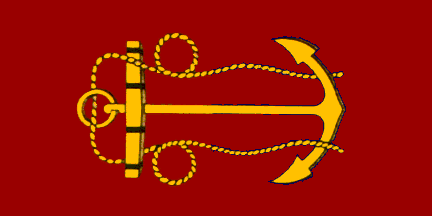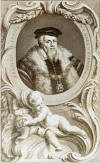My 17th Great Grandfather? - Theobald Russell
Born 1303. Married 1st Eleanor Gorges (dau. & heiress of Ralph III De Gorges, 1st Baron Gorges, & Eleanor who remarried Guy De Ferre and/or John Peche). Married 2nd Eleanor De la Tour (daughter of John De la Tour). Died 1340.
Other sources say he died 1349 leading the local forces against a french invasion of the Isle of Wight.
"Theobald Russel of Carisbrooke Castle, Isle of Wight".
"Theobald Russell of Yaverland in Isle of Wight, Kingston Russell in Dorset, and Horsington in Somerset."
Listed in 1316 as holding 8 manors while still a minor: "2 in Glos., 1 in Wilts., 1 in Som., & 4 elsewhere".
[My own attempt to tally these] Presumably these 8 are i) Dyrham & ii) Aust (both Newmarch inheritances) in Glos., iii) the unnamed Newmarche inheritance in Wilts., iv) Horsington (another Newmarch inheritance) in Som., and the "4 elsewhere" would be v) Kingston Russell in Dorset (Paternal inheritance), vi) Yaverland in the Isle of Wight (Paternal inheritance), vii) Upton Russell Berks. (now Oxon.) (Newmarch inheritance), and viii) Hardwick & Kimble in Bucks. (possibly counting as one?) (Newmarch inheritance). Him and/or his son Ralph later added 2 more manors in the Isle of Wight.
Berwick house in the parish of Swyre, Dorset, came into the Russell family from the de la Tour's through the marriage of Theobald & Eleanor.
Had sub-infeudenated Dyrham away by 1347 but Dyrham had been re-acquired in chief by the family at some point before his grandson Maurice's 1st marriage, upon which event it was granted to Maurice and Maurcie became the first Russell to be resident at Dyrham.
Four Children:
from 1st marriage to Eleanor Gorges-
- Ralph Russell of Kingston Russell (1319-1375), Knt. "of the Isle of Wight", m. Alice ?
- Theobald Russell
- John Russell
Theobald & John both fl. 1341 and dead before 1377.
- Sir Maurice Russell (c.1352/6-1416), of Dyrham & Kingston Russell, etc., Knt., Knt. of Shire for Gloucestershire, Sheriff of Gloucestershire, etc., m1. Isabel Childrey, m2. Joan Dauntsey
- Alice Russell, m. ? Haket
- William Russell (died sp)
- Sir Theobald Russell Gorges* (?-1380), m1. Margaret Beauchamp, m2. Agnes De Wyk
- Sir Randolf (Ralph?) Gorges (?-1382)
- Bartholomew Gorges (?-1395/6), m. Elizabeth ? (had 3 daughters)
- Thomas Gorges of Wraxall (?-1404), m. Anges Beauchamp (she married 2nd Thomas Norton)
- William Gorges, m. Margaret ?
*=Part of the marriage agreement between Theobald Russell & Eleanor Gorges was that one of the younger children (if any were produced) would take up the Gorges surname to continue it.
from 2nd marriage to Eleanor De la Tour-
- William Russell
| |
An unknown descendant (Son?, Grandson?) of Ralph Russell (see above) who was in someway ancestor (Father? Grandfather? Great-Grandfather? etc.) of Stephen, below.
Some sources equate this with:
My 17th Great Grandfather?, Thomas Russell, M.P.
M.P. for Melcombe Regis who died circa 1390. |
| My 18th Great Grandfather?, Robert Russell
Born abt. 1314 in Strensham, died 1376. Married Katherine Vampage |
My 17th Great Grandfather?, Sir John Russell
Born abt. 1340 in Strensham, died 1409. Married 1st Agnes/Ann Planches. Married 2nd Margaret Hastings. Possibly married 3rd Elizabeth De La Plaunche?
possibly MP for Worcestershire?
Master of Horse.
5 or 6 Children (all with 1st wife):
- Stephen Russell
- Joan Russell (~1354-?), m1. Thomas Quartermain, m2. John Credy
- Matilda "Maude" Quartermain
- Elizabeth Quartermain, m. Nicholas Englefield
- John Quartermain
- Guy Quartermain
- Richard Quartermain
- William Russell (~1368-1428), m. Agnes Haddington
- Margaret Russell (~1370-?), m. Ralph/Ralffe Rochford
- Elizabeth Russell (~1374-?), m. Sir Robert Wingfield of Lethringham
- Robert Wingfield (1403-1454) of Lethringham, Sir Knight, Knight of the shire Suffolk, Hertfordshire, Steward of the Duke of Norfolk, m. Elizabeth Goushill
- William Wingfield, m. Elizabeth Barnake
- Anne Wingfield (~1407-?)
- Margaret Wingfield (~1409-?), nun
- John Russell
|

 My 12th Great Grandfather, John Russell, 1st Earl Bedford, KG, PC, Lord Privy Seal
My 12th Great Grandfather, John Russell, 1st Earl Bedford, KG, PC, Lord Privy Seal Lord High Admiral in 1540-1542.
Lord High Admiral in 1540-1542. My 11th Great Grandfather, Francis Russell, 2nd Earl Bedford, KG, PC
My 11th Great Grandfather, Francis Russell, 2nd Earl Bedford, KG, PC My 10th Great Grandfather, Francis William Russell, Lord Russell
My 10th Great Grandfather, Francis William Russell, Lord Russell